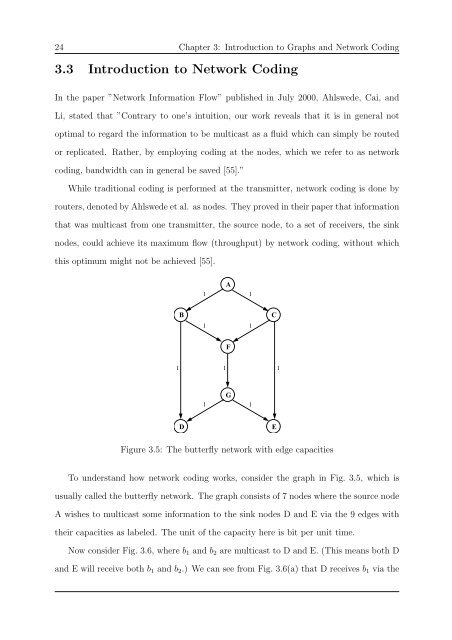Network Coding and Wireless Physical-layer ... - Jacobs University
Network Coding and Wireless Physical-layer ... - Jacobs University
Network Coding and Wireless Physical-layer ... - Jacobs University
Create successful ePaper yourself
Turn your PDF publications into a flip-book with our unique Google optimized e-Paper software.
24 Chapter 3: Introduction to Graphs <strong>and</strong> <strong>Network</strong> <strong>Coding</strong><br />
3.3 Introduction to <strong>Network</strong> <strong>Coding</strong><br />
In the paper ”<strong>Network</strong> Information Flow” published in July 2000, Ahlswede, Cai, <strong>and</strong><br />
Li, stated that ”Contrary to one’s intuition, our work reveals that it is in general not<br />
optimal to regard the information to be multicast as a fluid which can simply be routed<br />
or replicated. Rather, by employing coding at the nodes, which we refer to as network<br />
coding, b<strong>and</strong>width can in general be saved [55].”<br />
While traditional coding is performed at the transmitter, network coding is done by<br />
routers, denoted by Ahlswede et al. as nodes. They proved in their paper that information<br />
that was multicast from one transmitter, the source node, to a set of receivers, the sink<br />
nodes, could achieve its maximum flow (throughput) by network coding, without which<br />
this optimum might not be achieved [55].<br />
A<br />
1 1<br />
B<br />
1 1<br />
C<br />
F<br />
1 1 1<br />
G<br />
1 1<br />
D<br />
E<br />
Figure 3.5: The butterfly network with edge capacities<br />
To underst<strong>and</strong> how network coding works, consider the graph in Fig. 3.5, which is<br />
usually called the butterfly network. The graph consists of 7 nodes where the source node<br />
A wishes to multicast some information to the sink nodes D <strong>and</strong> E via the 9 edges with<br />
their capacities as labeled. The unit of the capacity here is bit per unit time.<br />
Now consider Fig. 3.6, where b 1 <strong>and</strong> b 2 are multicast to D <strong>and</strong> E. (This means both D<br />
<strong>and</strong> E will receive both b 1 <strong>and</strong> b 2 .) We can see from Fig. 3.6(a) that D receives b 1 via the

















